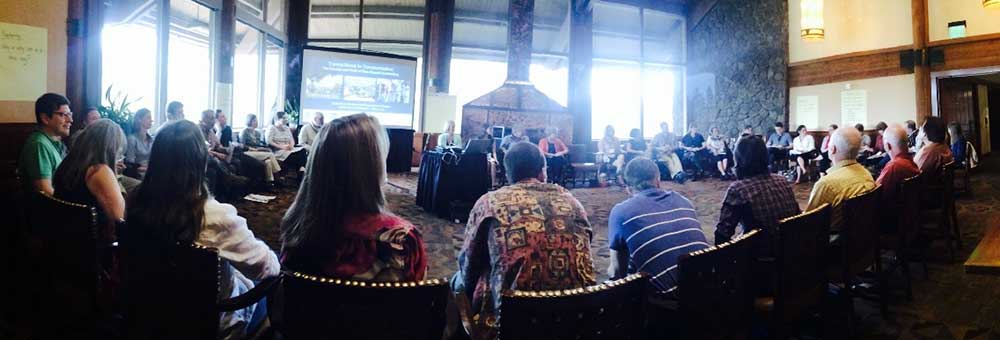by Richard Woo and Holly Powers, The Russell Family Foundation
(Cross-posted from the TRFF blog)

When a foundation wants to tackle an ambitious goal – say, helping restore an entire watershed – is it enough for them to simply fund a nonprofit or two?
The answer is obviously no.
What’s less clear, however, is how to engage, who to fund, and for how long.
The challenge – known to some as transformational philanthropy (systemic, collaborative grantmaking with an eye toward long-term change) vs. transactional philanthropy (traditional, over-the-transom, time-limited, project-based grantmaking) was a core theme at The River Gathering, a conference co-presented by Philanthropy Northwest (@philanthropynw) and GRANTMAKERS of Oregon and Southwest Washington.
The topic also took center stage at the three-hour breakout session Transactional to Transformative: The Promise and Peril of Place-Based Grantmaking organized by Bonneville Environmental Foundation / Model Watershed Program (Jennifer Arnold, Todd Reeve, Robert Warren), Laird Norton Family Foundation / Watershed Stewardship Program (Katie Briggs), The Russell Family Foundation / Puyallup Watershed Initiative (Henry Izumizaki, Holly Powers, Fabiola Greenawalt) and Meyer Memorial Trust / Willamette River Initiative (Pam Wiley).
At the beginning of the session, the facilitators explained to more than 40 attendees from the environment, human services, diversity/equity and government giving sectors that this wouldn’t be a lecture, but rather a deep-dive focused on building community, finding answers, and asking tough questions.
By the end of the session, the group had collectively captured dozens of pearls of wisdom from their experiences in the field, with the main realization being that if they want to do transformative work, then must first transform themselves and their approach to grantmaking.
Transformation, of course, is never easy. Here are a few tangible steps as identified by the group that grantmakers can use to further transform their work:
- Pick broad goals; it’s about the soil, not the fruit. Too often, foundations try to over-control for outcomes. For example, environmental funders will focus on salmon restoration along the banks of a river instead of building the leadership and capacity of watershed leaders to develop collaborative, long-term plans for thriving salmon populations. Instead, it is important to embrace uncertainty, go slow before you go fast, and build alignment around social capacity.
- Identify an organization to look out for all interests. Foundations should be clear that transformational philanthropy means giving up power; that’s what leads to change. As a funder, you’ll need to recognize your own limits and capacity. Consider giving grants to an intermediary or umbrella organization that can embed into the community and build an understanding of the circumstances, geography, institutions, science, gaps and bottlenecks. The idea behind this approach is that community-based organizations – often not foundations – are the ones who know how to move an issue through complex social, political and business webs.
- Communities of Interest (COIs) are important to placed-based grantmaking. COIs are self-defined and self-organized groups with a shared interest in their communities. COIs (example: farmers, ranchers, environmental groups, diversity advocates, etc. based in one watershed) offer an “open table” for new ideas. You can’t truly get to work in a place without organizing, listening to, and understanding the perspective of COI’s. They provide strong local leadership, community engagement, leveraged funding, and an understanding of values, problems and impact. The nonprofits that foundations support aren’t used to putting together joint applications, budgets, evaluation systems and leadership structures. Challenging community-organizations to pull off true collaboration means that foundations need to rethink grantmaking systems and incentives.
- Be prepared to stay engaged for more than 10 years. What happens after 10 years? Momentum is just picking up, and that’s often when the money runs out. In reality, transformational philanthropy tied to an initiative can take 10 years, 20 years – or even more. Throughout the process, foundations probably won’t be able to connect all the dots between the investments and the outcomes because they won’t know what the outcomes will be. Funders have to be prepared to engage and fund through the storms and sunny days over a period of a decade, maybe two. In the beginning, the community will likely set goals that are too ambitious, and they will get refined over time; this is ok – in transformational philanthropy, flexibility, adaptability and learning are key.
- Make the tent as big as possible. Let’s face it: The landscape and entry points are different with every place-based approach. And, what a funder sees as impactful may not match what the people on ground want funded. One way of addressing this might seem counterintuitive: Make the tent as big as possible. Welcome everyone, and encourage grantees and community partners to build their own big tents. The more people involved in the process, the more likely you are to find a solution. Seeking out new and non-traditional voices creates ripple effects, and that, of course, may mean that long relationships might have to transition or change (which can be difficult for long-time grantees). You can’t achieve system change, however, without new voices, and that’s exactly what’s needed in nearly all areas of philanthropy. Consider adopting a long-term process to cultivate and build the capacity of grassroots groups to you can engage.
- You don’t need a crisis in order to organize. If you can find the self-interest of a community and successfully tap into it, that’s a great place to start. Meet people where they are and move forward. Conditions don’t need to be perfect to start…you just need to start.
- The learning curve is steep. Changing the way we make grants and engage communities is about more than just better outcomes or even deeper learning - it’s about building trust. That only happens by chasing the right questions instead of the right answers. People have different languages, education, interests and goals, and you have to meet with everyone – again, build a big tent – and then work closely with the people with the most promising ideas. The learning doesn’t have to be technical – you just have to find the right questions.
- Be the first resort, not the last. A foundation knows it’s engaging effectively in transformational philanthropy when a) it’s seen as a knowledge holder for place-based work, b) it gives power away to the community in the places it invests in, and c) it creates an open, inclusive process that encourages more participation in decision-making, not less. Often, foundations are brought in when a community or initiative is ready to ask them for money (the last step/resort). Funders should consider what it would look like to be the first resort – with grantmaking processes in place that help shape progress and develop ideas from the ground-up.
- If not consensus, then common vision. Of course, consensus is always the goal. Consensus resonates with the power of the big tent; it is the process for how to build a tent that everyone can fit under. Everyone doesn't have to love the tent, but they see value in being together out of the rain and they'll speak up and work with the group to reshape it if it's really a problem. The concept of consensus is at the heart of the work. But let's face it: Sometimes consensus just isn't not possible. Foundations and intermediaries working with large groups can’t force people to align across the spectrum of issues that matter to them in their “place.” If consensus isn't possible then seek common vision, which is a focus on finding three strategies that 10 or 20 grantees can see themselves in (even if they aren’t perfectly aligned), and work with the umbrella organization to manage the effort and guide the process forward. Either approach -- consensus or common vision -- will keep the effort moving forward.
- “Place” is hard to define. “Place” can be defined geographically, environmentally or socially, so don’t just limit thinking to a boundary-line on a map. While the outcomes of place-based philanthropy aren’t always clear, it’s the relationships, people, and context that matter. Focus on what’s unique about a community and then tailor the definition of place, problems and possible solutions.
- Money won’t solve the problem. Transformational philanthropy is necessary because social and environmental conditions are worsening, and often foundations are pulled in to help solve complex challenges. This work is ultimately a community experiment, and everyone knows that money is not going to solve the problem at the end of the day. In fact, it is often part of the problem. People who are key to solving the problems are all-to-often on the other side of the fence when they could be key allies. Foundations must deal with the full scale of the problem, and the community it impacts. Without a strong community fabric, money thrown at the problem simply won’t work.
Transformational grantmaking requires a significant, long-term financial investment on the part of foundations, which means that both board and staff must be aligned and fully bought-in to the process. The time to develop, shape, monitor and manage this work is significant, which means that foundations will spend large amounts of time on a few proposals vs. all of their time considering isolated pitches. The foundation itself – or an intermediary – then becomes the anchor institution in long-term efforts.
Perhaps the scariest step for foundations in this committing to long-term efforts without identifying any particular solution in advance – hence the promise and peril of transformational grantmaking. Foundations must let an integrated collective of grantees control the work, and they must have the patience to stay with the initiative for years – at least 10 or more.
This approach requires a fundamental shift in how funders see their role and engage. Without this shift, the world will continue to look largely as it does today: lots of individual projects, and not enough systemic change.
Richard Woo has served as the CEO of The Russell Family Foundation for 15 years, with a focus on finding quiet leaders that typically haven’t been recognized by giving organizations. Twitter: @richardwoogle.
Holly Powers is a Program Officer at The Russell Family Foundation and focuses her work on building community. She leads the organization’s watershed restoration efforts. Twitter: @hollyepowers.


